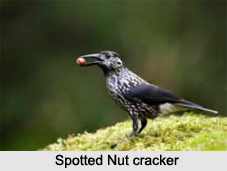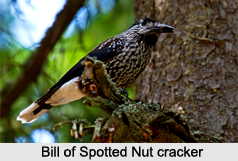 Spotted Nutcracker or Eurasian Nutcracker, or just Nutcracker is an Indian Bird that bears a scientific name "Nucifraga caryocatactes" and falls in the nut cracker family.
Spotted Nutcracker or Eurasian Nutcracker, or just Nutcracker is an Indian Bird that bears a scientific name "Nucifraga caryocatactes" and falls in the nut cracker family.
Category of Spotted Nutcracker
Spotted Nutcracker or Eurasian Nutcracker is a passerine bird slightly larger than the Eurasian jay.
Structure of Spotted Nutcracker
Spotted Nutcracker or Eurasian Nutcracker has a much larger bill and a slimmer looking head without any crest. The feathering over its body is predominantly a chocolate brown with distinct white spots and streaks. The wings and upper tail are virtually black with a greenish-blue gloss. It is one of three species of nutcracker. The large-spotted nutcracker (Nucifraga multipunctata), was formerly considered a subspecies. The other, Clark`s nutcracker (Nucifraga columbiana), occurs in western North America.
Description of Spotted Nutcracker
Spotted Nutcracker or Eurasian Nutcracker was one of the many species originally described by Linnaeus in his 18th century work, Systema Naturae and it still bears its original name of Nucifraga caryocatactes.
Colour of Spotted Nutcracker
Spotted Nutcracker or Eurasian Nutcracker is a dark brown, broad-winged, short-tailed corvid. Body plumage is mid to dark chocolate brown, heavily spotted with white on face, neck, mantle and under parts. It has a large white loral spot, a white eye-ring, blackish brown cap extending onto the nape, dark blackish wings with a greenish-blue gloss, all white vent, and dark tail with white corners above and a white terminal band on the undertail.
Flight of Spotted Nutcracker
In flight, broad wings, white vent and short tail are noticeable; the flight undulating. The black bill is slender and rather long, sharply pointed, and varies in size amongst races. The iris, legs and feet of Spotted Nutcracker or Eurasian Nutcracker are black.
Size of Spotted Nutcracker
Spotted Nutcracker or Eurasian Nutcracker ranges from 32-38 cm in length (from tip of beak to tip of tail) and have a wingspan ranging from 49-53 cm.
 Sound of Spotted Nutcracker
Sound of Spotted Nutcracker
The voice of Spotted Nutcracker or Eurasian Nutcracker is similar to that of the Eurasian jay and is loud and harsh. It is described as kraak-kraak-kraak-kraak.
Feeding of Spotted Nutcracker
Spotted Nutcracker or Eurasian Nutcracker eats various insects and also small birds, their eggs and nestlings, small rodents and carrion. It digs out bumble bee and wasp nests avidly to get at the grubs.
Behaviour of Spotted Nutcracker
The couples of Spotted Nutcracker or Eurasian Nutcracker stay together for life and their territory expands between 20 and 30 acres. The nesting of Spotted Nutcracker is always early in this species across its whole range, so as to make the best use of pine nuts stored the previous autumn.
Nests of Spotted Nutcracker
The nest of Spotted Nutcracker or Eurasian Nutcracker is usually built high in a conifer (sometimes broadleaved trees are used) and usually on the sunny side. There are normally 2-4 eggs laid and incubated for 18 days.
Sexes of Spotted Nutcracker
Both the sexes of Spotted Nutcracker feed the young who are usually fledged by about 23 days and stay with their parents for many months, following them to learn the food storage techniques essential for survival in their harsh environment.
Concentration of Spotted Nutcracker
The concentration of Spotted Nutcracker has an extensive range forming a broad swathe east-west from Scandinavia right across northern Europe, Siberia and to eastern Asia, including Japan, inhabiting the huge taiga conifer forests in the north.
Nature of Spotted Nutcracker
Spotted Nutcrackers are not migratory, but will erupt out of range when a cone crop failure leaves them short of a food supply, the thin-billed eastern race Macrorhynchos being the more likely to do this.



















